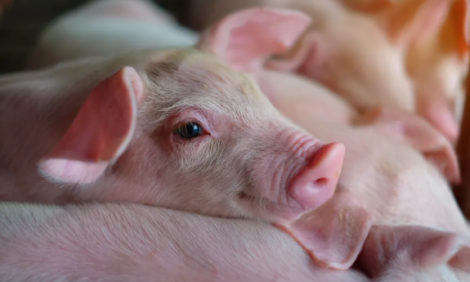



Sow Bodyweight Changes in Gestation
By Dana R. Cooper, John F. Patience, Ruurd T. Zijlstra and Meike Rademacher - Defining nutrient requirements and feeding strategies for the modern high-producing sow is a step leading to greater efficiency in the breeding herd. Results demonstrated that setting target weight gains in gestation and feeding to meet these targets might not always provide predictable results.Introduction
There are two steps in the design of a feeding strategy. The first is to set reproductive targets including the amount of maternal weight gain for sows of differing parities and the amount of reserves a sow can use for milk production in lactation. The second step is to set nutrient requirements to meet these specified targets. Models have been developed for sow nutrient requirements in gestation. These models attempt to patition nutrient requirements into three components (maintenance, growth of conceptus and reproductive tissues and maternal growth). By attempting to partition requirements, factors are added up, thus accounting for the factorial approach to determining nutrient requirements. The object of this experiment was to evaluate the factorial approach to defining energy requirements in pregnant sows.
Experimental Procedures
Daily feed allowance in gestation was determined using the maintenance requirement for energy of 110 kcal DE/kg BW0.75 and total target sow BW gains, including maternal gain and growth of the conceptus, of 55, 50, 40, 30 and 20 kg for parities 1, 2, 3, 4 and 5 and higher, respectively. Feed allowances were calculated using BW at mating and the target BW gains set for each parity. Example calculations are demonstrated in Table 1.
Daily feed allowance of sows in gestation was closely monitored. Sows were fed their daily allowance as one meal in the morning. Sow BW was measured at mating, d 35, 75 and 110 gestation. The experiment was conducted over 3 replicates. After the first replicate, it was apparent that first and second parity sows gained an average of 9.6 and 13.3 kg more than targeted, respectively. In replicates 2 and 3, the daily energy allowances of these two parities was adjusted downward based on the energy required for protein and lipid gain to achieve the prescribed gestation BW gain. The calculation resulted in decreasing the average daily feed allowance by 100 g/d.
Results and Discussion
Sows gained an average of 10.6 kg above the target total gestation BW gain. It was clear that this model over-predicted DE allowance for sows in gestation, therefore, performance data for the sows was entered into the NRC (1998) model (Table 2). The actual number of piglets farrowed was put into the NRC (1998) model, a component not entered into the original model that was used. Comparisons between the predicted BW gain and the actual BW gain were then made. The deviation between the predicted and actual BW gains was then orgainized by parity, BW at breeding, totoal number of piglets born and the total weight of the litter born (Figures 1 and 2). The deviations between predicted and actual gains (NRC prediction – Actual BW gains) decreased with increased parity and initial BW at breeding until the 5th parity and a BW range of 210-240 kg, where it then increased. NRC (1998) obtained the closest estimate of BW gain in gestation for sows with litters larger than 11 piglets and litters weighing between 14-17 kg at birth.
Implications
Predicting daily DE allowances that will maximize sow and litter performance is possible with sows between parity 3 and 5. There is too much variation in younger parity sows and older parity sows to predict sow performance with any accuracy; therefore, there is a need for further research into this area. The size and weight of the litter at farrowing is important in determining the BW gain of the sow in gestation. Therefore, using the actual litter size and weight within a sow herd is desirable when using a factorial approach to determine daily feed allowance.

To view the full report, including tables, click here. (PDF format)
March 2004








